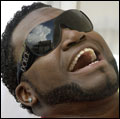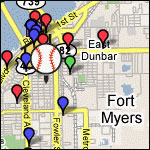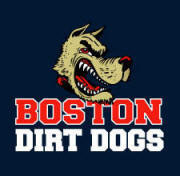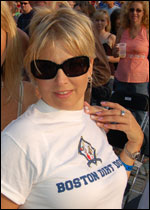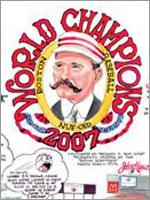Learning Japanese
|
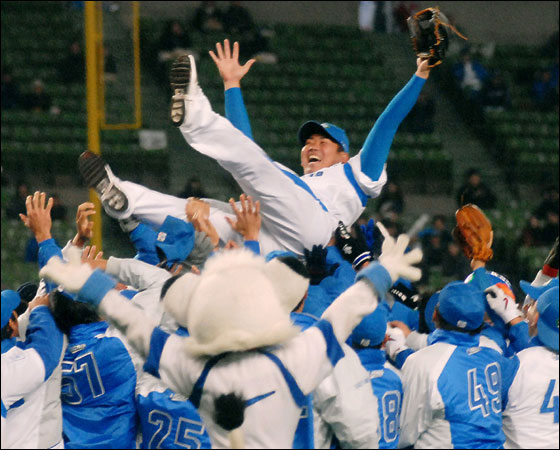
|
|
(AP Photo) |
An afternoon sun illuminates the foliage extending in every direction beyond Invoice Seibu Dome on the outskirts of Tokorozawa, and casts its natural light into 29,187 spectators through the breach between original grandstands and retrofitted dome. The horizontal band of sunshine circumnavigates the stadium, splitting the fuzzy manmade lumens into two pools, one reflecting from the dome above, the other from the concourses below.
This is Daisuke Matsuzaka's house and the gathered crowd is well aware that today could be his final day of home confinement. Speculation is rampant that Seibu Lions ownership will honor his year-old request to be posted at season's end, thereby paving his way to America. But there are neither tears nor long faces in the seats. Rather, an electric energy ripples through the crowd. This is yakyu -- Japanese baseball -- at its peak. The second-place Lions are hosting the third-place SoftBank Hawks in this best-of-three first stage that will ultimately decide the Pacific Division delegate to the 2006 Japan Series.
The Lions emerge from their first-base dugout and take the field, a pale-green Astroturf reminiscent of any National League surface with only minimal breaks to accommodate each base and pitcher's mound. But this is the extent of any NL comparison. The Pacific is the younger and more rebellious of the two leagues comprising Nippon Professional Baseball (NPB), Japan's MLB equivalent. There is no 'Japan League'; the term is a stateside misnomer. And, unlike in the Central League, Matsuzaka must face a designated hitter each night.
On this Saturday afternoon of what is Columbus Day weekend back in the States, the Seibu Lions' cause will be furthered by the presence of their ace, who takes the mound for warm-ups. They will need it. Lions hitters will be going up against the best pitcher in NPB, SoftBank's Kazumi Saitoh.
As hard as it is to believe, $51.1 million doesn't even buy the exclusive right to negotiate with Japan's best.
Granted, Matsuzaka is not chopped sushi. He finished a close second to Saitoh in every major pitching category: wins (Saitoh 18, Matsuzaka 17), ERA (1.75 vs. 2.13), strikeouts (205 vs. 200), and innings pitched (201 vs. 186). While this is a typical Dice-K season, it is a career year for the 29-year old Saitoh, who will soon be the unanimous winner of the Sawamura Award, NPB's equivalent to the Cy Young. But this afternoon belongs to Matsuzaka.
Dice-K scatters six hits -- along with four hit batsman -- over a complete game shutout, striking out 13 while walking none. The only run of the game scores in the bottom of the seventh when the Lions lead off with three straight hits, capped by Kazuhiro Wada's RBI double. Saitoh gives up only one other hit in eight innings of work, striking out nine while walking two, but is the hard-luck loser. Nevertheless, in two days' time, Saitoh's Hawks will go on to eliminate Matsuzaka's Lions, two games to one.
This opener was vintage yakyu, where managers sit back and enjoy the pitching performances right along with the fans. Saitoh threw 115 pitches, Matsuzaka 137, and neither bullpen gate so much as creaked, leaving many purists outside Japan longing to see these global treasures swept under the protectionist wings of American baseball.
High pitch counts among Japanese pitchers in general and Matsuzaka in particular have long been a concern among Major League scouts and front offices. Possession of this general awareness is one thing, but to be armed with the specifics (forgive the pun) is another matter altogether.
As a 17-year old, Matsuzaka's 17-inning, 250-pitch performance in the 1998 Koshien Summer Championships is folklore, even in Japanese circles. From there, his iron legend would only grow. By the age of 21, Dice-K had started 80 games in three big-league (read: no minors) seasons, facing almost 2,500 batters in 588 innings of work. That's an average of seven and one-third innings per start.
After rebounding from a 2002 injury, it was not uncommon for Matsuzaka to throw 160 pitches in a given outing. Last year, his seventh in NPB, Matsuzaka started 28 games, with pitch counts ranging from a low of 76 to a high of 160, that coming on his second start of the season. He threw over 100 pitches 25 times, including four outings between 121 and 132, and 11 of more than that. These last two groupings may sound a bit arbitrary, but they are the definitions of Categories 4 and 5 events, respectively, in Baseball Prospectus's Pitcher Abuse Points (PAP) analysis system. Dice-K's average 2005 outing was 122 pitches.
In comparison, this past season seemed like Club Med. In 26 starts, which included his one playoff game against SoftBank, Matsuzaka threw over 100 pitches on 19 occasions. Half his starts were at least of the Category 4 variety (122-plus); six were outright Category 5 (133-plus). His high outing was 145 on Sept. 19 and he averaged 115, excluding one June start in which a groin pull prevented him from finishing the first inning.
Now, the Seibu Lions, like most Nippon Professional Baseball teams, employ a six-man rotation. Further, with few exceptions, the NPB takes Mondays off and never schedules more than six consecutive days of games, meaning Matsuzaka pitched once per week at best. In fact, only one start came on as little as six days' rest. Nonetheless, the damage may have already been done, this according to the gurus at Baseball Prospectus, the think tank as rich in devising objective measurements of subjective factors as they are bankrupt in devising clever names for them. Enter Pitcher Abuse Points.
Introduced in 1999 as a follow-up to Craig Wright's biblical "The Diamond Appraised" (Simon and Schuster, 1989) and refined in 2001, Pitcher Abuse Points is a system that assigns a numerical stress factor to each pitcher based on the sum of his performances over a season. Stress factors increase for each outing in which he throws more than 100 pitches, but can never decrease. The theory is that longer recovery periods do not mitigate the risk of subsequent flat performance or injury caused by an overworked outing. You can't un-ring this bell.
According to Baseball Prospectus rankings, the Diamondbacks' Livan Hernandez was a three-peat stress champion in 2006. With 19 of his 34 starts lasting over 100 pitches, he topped the Majors with a factor of 42. After Curt Schilling's infamous 133-pitch outing in Cleveland last April -- one of his 23 starts in excess of 100 pitches -- he went 2-2 with a 6.46 ERA over his next four outings, but still tallied a modest factor of only 18.
Against these numbers, Dice-K's 2006 season blew away the MLB competition. His factor was a stratospheric 176. Nevertheless, this was considerably less stressful than his 284 in 2005.
BP can even tell you a pitcher's probability of a major injury (a DL stint of 30 or more days) based on stress, and they have corroboration. Historical injury data does suggest a correlation between their factor and resulting injury. Needless to say, D-Mat has a much higher probability of major injury than any current Major League pitcher, according to this particular geek stat. Maybe Carl Pavano doesn't look so bad after all.
In all fairness, although Matsuzaka has not yet paid the injury piper, he may have made a down-payment. Little data is available on his guarded medical history. As mentioned, he was pulled in the first inning of a game in June due to a groin injury, which also caused him to miss his next scheduled start. In 2002, he posted career lows with 11 starts and 14 appearances, having been removed from the Lions' 28-man active roster on two occasions -- once in May and again in August. The latter was reportedly due to a pulled hamstring in his right leg. There was speculation that the May stint was elbow-related, but nothing was ever confirmed.
To most observers, Matsuzaka's health seems like an ear of corn, the fitness of whose inner kernels are not betrayed by its thick green husk. Given that, how does the Red Sox front office navigate the Belichickian state of Japanese injury data? Hopefully, Theo will be able to peel away the husk, separate the silk, and see for himself before taking all those dollars out of Julio Lugo's pockets.
One thing is for sure: this is a Hot Stove League like no other.
-- Bob Ekstrom, Boston Dirt Dogs contributor and writer at Sports Central





